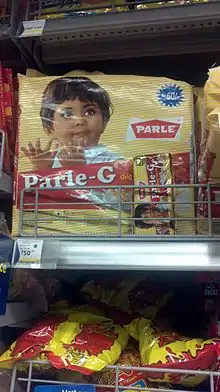Parle-G
Parle-G is a brand of biscuits manufactured by Parle Products in India. A 2011 Nielsen survey reported it is the best-selling brand of biscuits in the world.[1]
 Parle-G Biscuits | |
| Owner | Parle Products |
|---|---|
| Country | India |
| Markets | Worldwide |
| Tagline | The Tasty Healthy Food: World's Largest Selling Biscuit |
| Website | parleproducts.com |
History
Parle Products was established as a confectionery maker in the Vile Parle suburb of Mumbai, in 1929. Parle Products began manufacturing biscuits in 1939. In 1947, when India became independent, the company launched an ad campaign, showcasing its Gluco brand of biscuits as an Indian alternative to British-branded biscuits.[2]
Parle-G biscuits were earlier called 'Parle Gluco' Biscuits until the 1980s. The "G" in the name Parle-G originally stood for "Glucose", though a later brand slogan also stated "G for Genius".[3]
In 2013, Parle-G became India's first FMCG brand to cross the ₹5,000 crore mark in retail sales.[4]
Popularity
Primarily eaten as a tea-time snack, Parle-G is one of the oldest brand names in India. For decades, the product was instantly recognized by its iconic white and yellow wax paper wrapper. The wrapper features a young girl (an illustration by Everest creative Maganlal Daiya back in the 1960s).[5]
Parle-G has recently become available in plastic wrapping. The modern packaging retains its traditional design. The change in materials was promoted with advertisements showing a Parle-G packet placed into a fish tank.
As of January 2013, Parle-G's strong distribution network covered over 6 million retail stores in India.[6] The Brand Trust Report ranked Parle-G as the 42nd most trusted brand of India in 2014.[7]
The low price is another important factor in Parle-G's popularity. Outside India, it is sold for 99 cents for a 418 gram pack as of 2012. A more common 80-gram "snack pack" is sold for as low as 15 cents (5 INR) at Indian grocers, and 40 cents at major retailers. Rs 2 packs of Parle-G are also sold.[8][9] By 2016, smaller 56.4-gram packs were being sold as eight for one dollar at Indian grocers in the United States. Also the first TV commercial for Parle-G was made in 1982. The Indian superhero Shaktiman also endorsed the brand in the 1990s.[9]
See also
References
- "Parle-G world's No 1 selling biscuit: Nielsen". Economic Times. 2011-03-03. Retrieved 2011-10-12.
- Jill Didur (2006). Unsettling partition: literature, gender, memory. University of Toronto Press. p. 22. ISBN 978-0-8020-7997-8.
- "Loading". Archived from the original on 2015-08-21.
- 72-year-old biscuit pioneer, Parle-G becomes India’s first homegrown Rs 5K crore FMCG brand. Economic Times, 13 February 2013.
- Shephali Bhatt (October 30, 2013). "The Chronicles of Parle-G". Economic Times.
- Will Parle-G be relevant to the next generation? by Preethi Chamikutty. Economic Times, 16 January 2013.
- "India's Most Trusted Brands 2014". Archived from the original on May 2, 2015.
- Tripathi, Dhirendra (2020-06-09). "Parle-G, coronavirus and the millions who ate that biscuit as they went home". mint. Retrieved 2021-01-15.
- 10 Unknown Facts About Parle-G, The Largest Selling Biscuit Brand In The World by Postoast. Jan 14, 2019 - Uploaded by Doordarshan National Blog.